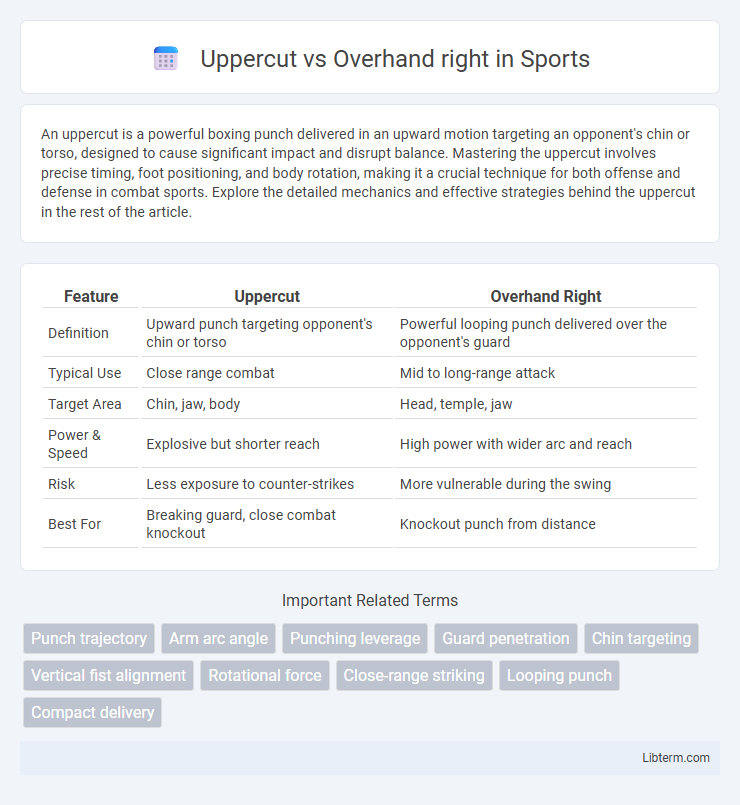An uppercut is a powerful boxing punch delivered in an upward motion targeting an opponent's chin or torso, designed to cause significant impact and disrupt balance. Mastering the uppercut involves precise timing, foot positioning, and body rotation, making it a crucial technique for both offense and defense in combat sports. Explore the detailed mechanics and effective strategies behind the uppercut in the rest of the article.
Table of Comparison
| Feature | Uppercut | Overhand Right |
|---|---|---|
| Definition | Upward punch targeting opponent's chin or torso | Powerful looping punch delivered over the opponent's guard |
| Typical Use | Close range combat | Mid to long-range attack |
| Target Area | Chin, jaw, body | Head, temple, jaw |
| Power & Speed | Explosive but shorter reach | High power with wider arc and reach |
| Risk | Less exposure to counter-strikes | More vulnerable during the swing |
| Best For | Breaking guard, close combat knockout | Knockout punch from distance |
Understanding the Uppercut and Overhand Right
The uppercut targets an opponent's chin or body using a rising punch that generates power primarily from the legs and hips, making it effective at close range. The overhand right delivers a looping, powerful strike aimed at the head, utilizing rotational force from the torso to maximize impact at mid to long range. Understanding the mechanics and optimal distance for each punch enhances accuracy and effectiveness in boxing strategy.
Mechanics of the Uppercut
The uppercut generates power through a compact, upward motion starting with a slight knee bend and hip rotation, driving force from the legs to the fist. Unlike the overhand right, which relies on a looping trajectory and shoulder rotation, the uppercut maintains a close range trajectory aimed at the opponent's chin or torso. Key mechanics include a tight elbow tuck, explosive upward thrust, and synchronized lower body drive to maximize impact while minimizing exposure.
Mechanics of the Overhand Right
The Overhand Right delivers power through a looping motion where the punching arm swings over the opponent's guard, utilizing torso rotation and a drop-and-drive of the rear shoulder. This punch engages the hips and legs to generate force while maintaining a compact motion to maximize speed and impact. Unlike the upward thrust of the uppercut, the Overhand Right combines vertical and horizontal momentum for a crushing, downward strike.
Key Differences Between Uppercut and Overhand Right
The uppercut is a vertical, rising punch targeting the opponent's chin or body, delivering powerful upward force in close-range combat. The overhand right is a looping, horizontal punch aimed at the opponent's head, utilizing momentum from the shoulder and arm to generate knockout power at mid to long range. Key differences include punching trajectory, target areas, and effective distance, with the uppercut excelling in close-quarters and the overhand right excelling in creating impactful, arcing strikes.
Situational Effectiveness: When to Use Each Punch
The uppercut excels in close-range combat, targeting an opponent's chin or solar plexus to disrupt balance and create openings. The overhand right is most effective at mid-range, delivering powerful, looping strikes that can bypass an opponent's guard and exploit defensive gaps. Choosing between these punches depends on distance, opponent's stance, and timing, with the uppercut favored during infighting and the overhand right suitable for counterattacks or breaking through high guards.
Advantages of the Uppercut
The uppercut delivers powerful close-range strikes targeting an opponent's chin, making it highly effective in tight quarters where overhand rights may lack precision. Its upward trajectory exploits vulnerabilities in an opponent's guard, increasing the chance of a knockout or staggering blow. This punch also facilitates quick combinations, creating openings for follow-up attacks and disrupting the opponent's defense more efficiently than the wider, more telegraphed overhand right.
Advantages of the Overhand Right
The Overhand Right delivers a powerful, arcing punch that can penetrate an opponent's guard more effectively than the upward trajectory of an Uppercut. Its wide, looping motion generates significant torque, maximizing power and knockout potential in close to mid-range combat. This punch also offers better reach and leverage, allowing fighters to exploit openings from various angles and disrupt an opponent's rhythm.
Common Mistakes and How to Avoid Them
Common mistakes in executing the uppercut include dropping the guard and over-rotating the hips, which reduce power and leave the boxer vulnerable to counterattacks. For the overhand right, fighters often telegraph the punch by raising the elbow too high or stepping in too predictably, compromising speed and accuracy. To avoid these errors, maintain a tight guard during the uppercut and practice smooth, compact hip rotation, while for the overhand right, keep the elbow close to the body and incorporate subtle footwork to enhance deception and fluidity.
Defensive Strategies Against Each Punch
Defensive strategies against the uppercut emphasize tight guard positioning and head movement to avoid the vertical trajectory, often using slip and roll techniques to minimize impact while preparing for counterattacks. In contrast, defending against the overhand right requires maintaining a high guard with the lead hand to block the wide, horizontal arc, combined with lateral head movement to evade the powerful, looping strike. Effective defense involves understanding the distinct angles and timing of each punch, ensuring precise anticipation and reaction to mitigate damage.
Training Drills for Mastery
Training drills for mastering the uppercut emphasize close-range accuracy and explosive upward motion, incorporating shadowboxing, heavy bag work, and partner mitt drills to refine technique and power. Overhand right drills focus on developing wide, looping strikes with rotational hip engagement through resistance band exercises, slip-and-counter routines, and heavy bag rotations to enhance timing and knockout potential. Combining both drills increases hand speed, improves defensive awareness, and builds muscle memory essential for effective in-fight execution.
Uppercut Infographic

 libterm.com
libterm.com